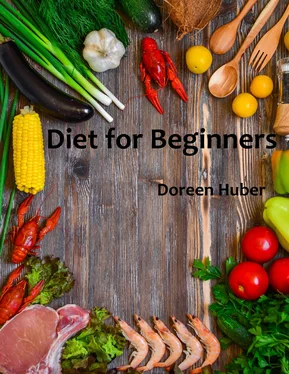Doreen Huber - Diet for Beginners
Здесь есть возможность читать онлайн «Doreen Huber - Diet for Beginners» — ознакомительный отрывок электронной книги совершенно бесплатно, а после прочтения отрывка купить полную версию. В некоторых случаях можно слушать аудио, скачать через торрент в формате fb2 и присутствует краткое содержание. Жанр: unrecognised, на английском языке. Описание произведения, (предисловие) а так же отзывы посетителей доступны на портале библиотеки ЛибКат.
- Название:Diet for Beginners
- Автор:
- Жанр:
- Год:неизвестен
- ISBN:нет данных
- Рейтинг книги:4 / 5. Голосов: 1
-
Избранное:Добавить в избранное
- Отзывы:
-
Ваша оценка:
- 80
- 1
- 2
- 3
- 4
- 5
Diet for Beginners: краткое содержание, описание и аннотация
Предлагаем к чтению аннотацию, описание, краткое содержание или предисловие (зависит от того, что написал сам автор книги «Diet for Beginners»). Если вы не нашли необходимую информацию о книге — напишите в комментариях, мы постараемся отыскать её.
Diet for Beginners — читать онлайн ознакомительный отрывок
Ниже представлен текст книги, разбитый по страницам. Система сохранения места последней прочитанной страницы, позволяет с удобством читать онлайн бесплатно книгу «Diet for Beginners», без необходимости каждый раз заново искать на чём Вы остановились. Поставьте закладку, и сможете в любой момент перейти на страницу, на которой закончили чтение.
Интервал:
Закладка:
In 1992, the National Heart, Lung and Blood Institute worked closely with five prestigious medical research centers in the US to design and carry out the largest and most detailed study ever conducted called “The DASH study.”
The DASH study was uniquely based on foods that the average person could buy at a local grocery store thus making it easy for anyone to implement.
The DASH study
The first DASH study began in 1993 and ended in July 1997. The study compared two experimental diets with one control diet. Each of the 459 screened participants were randomly selected to participate in one of three groups. They were instructed to follow the dietary pattern of that group for eight weeks in which time their blood pressure would be regularly checked.
The two experimental groups included:
Experimental diet group 1 – Fruits and vegetables diet
Other than a high consumption of fruits and vegetables this group was to eat the typical American diet with fewer sweets and snacks. Their fiber content was high and their magnesium and potassium levels were similar to 75% of people in the US.
Experimental diet group 2 – The DASH diet
This group was to consume a high intake of fruits, vegetables and low-fat dairy. Fat content was low and protein and fiber levels were high. This diet was rich in magnesium, potassium, calcium, fish, poultry, whole grains and nuts. The consumption of red meats, sweets and sweetened drinks was low. (This diet intentionally included foods that would reduce blood pressure. It also contained a lot of antioxidant rich foods).
Control group – The Control diet
This group was to consume food that was typical of the American diet - low in potassium, calcium, fiber and magnesium and high in protein and fat.
The results of the DASH study
The results of the DASH study proved that dietary patterns do affect people with moderate to severe hypertension.
The “fruits and vegetables” group experienced lower blood pressure but their decrease was not as significant as the DASH group. The participants in the DASH group that did not have hypertension experienced a decrease in blood pressure as well.
The study also showed that people with hypertension in the DASH diet group experienced a decrease in their blood pressure within only two weeks of starting the DASH diet.
The DASH sodium study
The second DASH study called “The DASH sodium study” was undertaken following “The DASH study” to see whether the DASH diet could lower blood pressure even more effectively if it were low in salt. The two main objectives of the “The DASH sodium study” were:
1. To study the effects of reduced sodium levels on the DASH diet
2. To study the effects of the DASH diet at three different sodium levels
The DASH sodium study was a large scale study that ran from 1997 to 1999. It involved 412 adult participants with stage 1 hypertension or prehypertension. There were two groups involved, the DASH diet group and the typical American diet group (the control diet group).
Each group was given a 30 day diet that included three different sodium levels: 3000 mg, 2400 mg and 1500 mg a day. Each diet was preceded by two weeks of high sodium control diet eating followed by 30 days of eating an assigned diet that randomized the sodium levels.
The results of the DASH sodium study
Both the DASH diet and the control diet were successful at lowering blood pressure at the lower salt levels but the biggest decrease in blood pressure was seen when the DASH diet was combined with low salt consumption of 1500 mg a day.
The results of this study also led researchers to propose that the national daily allowance of sodium be lowered. The U.S. Dietary Guidelines for Americans recommend 2300 mg of sodium per day or lower. 1500 mg of sodium a day is recommended for people who have high blood pressure.
Chapter 3 - Characteristics of the DASH Diet
The DASH diet is not necessarily a “diet” rather it is a way of eating that will promote long term health. The USDA (U.S. Department of Agriculture) recommends the DASH diet as “an ideal eating plan for all Americans.”
The NIH (National Institutes of Health) says that the DASH diet plan does more than promote good eating habits. It offers suggestions on healthy alternatives to junk food and processed food.
In addition to this, the creators of the DASH diet say that “not only is the DASH diet designed to bring down high blood pressure it is also a well-balanced approach to eating that encourages people to lower their intake of sodium (salt) and increase their consumption of calcium, magnesium and potassium.”
The characteristics of the DASH diet include:
Lower sodium intake
Increased vitamins and minerals
Increased good fats
Increased fiber consumption
Reduction of alcohol and caffeine
Customizable sodium and caloric intake
Lower sodium intake
The DASH diet provides guidelines for your sodium and caloric intake.
The standard DASH diet allows up to a maximum of 2300 mg of sodium per day and the low-sodium version of the DASH diet allows up to 1500 mg of sodium per day.
The average American diet contains up to 3500 mg of sodium per day.
Increased vitamins and minerals
All your essential vitamins and minerals are provided on the DASH diet by the many fruits, vegetables, whole grains and other whole foods that you are encouraged to eat on the diet.
The diet also includes an ample supply of minerals like magnesium and potassium that help to lower or improve your blood pressure.
Increased good fats
Consuming a lot of good fats and minimizing bad fats is highly encouraged on the DASH diet. Saturated and Trans fats should be replaced with lean meats, omega-3’s from fish and seafood, low-fat dairy, nuts and seeds.
Good fats help to optimize our overall health by lowering bad cholesterol and increasing good cholesterol.
Increased fiber consumption
The DASH diet recommends increasing your fiber consumption by eating several servings of fruits, vegetables and grains every day. This keeps you feeling full and helps to reduce blood pressure.
High fiber consumption also helps to maintain good blood sugar levels and it also encourages weight loss.
Reduction of alcohol and caffeine
The DASH diet suggests limiting your intake of alcohol, soda, tea and coffee because they offer no nutritional value, typically contain a lot of sugar and they can elevate blood pressure.
Customized sodium and caloric intake
In the same way that you can choose a 2300 mg/day or 1500 mg/day sodium intake DASH diet, you can also choose the most suitable caloric intake level for you. The DASH dietallows you to choose a diet of 1500 to 3100 calories per day.
The caloric intake that you choose will depend on your weight, activity level, whether you have high blood pressure now or want to prevent it etc.
If you are overweight you will likely opt for the lower caloric intake level. If you are active then you will likely choose the higher caloric intake level.
If you have high blood pressure or are at risk of developing high blood pressure due to family history etc. then you’ll likely opt for the low sodium diet. Consider working with your doctor to come up with the best combination of sodium and calorie levels for you.
Конец ознакомительного фрагмента.
Текст предоставлен ООО «ЛитРес».
Прочитайте эту книгу целиком, купив полную легальную версию на ЛитРес.
Безопасно оплатить книгу можно банковской картой Visa, MasterCard, Maestro, со счета мобильного телефона, с платежного терминала, в салоне МТС или Связной, через PayPal, WebMoney, Яндекс.Деньги, QIWI Кошелек, бонусными картами или другим удобным Вам способом.
Интервал:
Закладка:
Похожие книги на «Diet for Beginners»
Представляем Вашему вниманию похожие книги на «Diet for Beginners» списком для выбора. Мы отобрали схожую по названию и смыслу литературу в надежде предоставить читателям больше вариантов отыскать новые, интересные, ещё непрочитанные произведения.
Обсуждение, отзывы о книге «Diet for Beginners» и просто собственные мнения читателей. Оставьте ваши комментарии, напишите, что Вы думаете о произведении, его смысле или главных героях. Укажите что конкретно понравилось, а что нет, и почему Вы так считаете.












